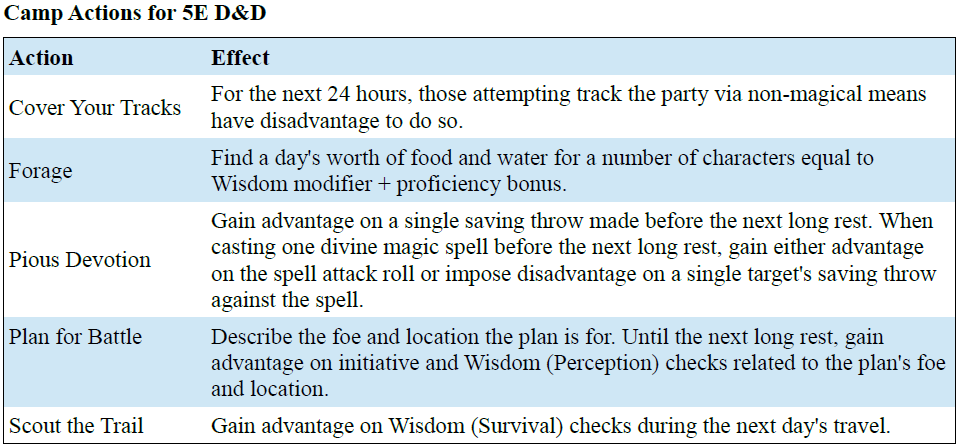Around the Campfire
The inclusion of various downtime activities is one of the more interesting parts of 5E D&D. Downtime activities are things that PCs may do between adventures. The 5E PH describes Crafting, Practicing a Profession, Recuperating, Researching, and Training. The 5E DMG expands the list with Building a Stronghold, Carousing, Crafting a Magic Item, Gaining Renown, Performing Sacred Rites, Running a Business, Selling Magic Items, Sowing Rumors, and a variant rule for Training to Gain a Level. I’ve been playing 5E D&D about twice a month for probably a couple of years. Downtime activities have rarely appeared in our games, and not for a lack of trying.
Insert awkward segue here.
I’ve continued my leisurely read-through of James M. Spahn’s second edition of The Hero’s Journey (THJ hereafter), The Hero’s Grimoire, and The Hero’s Companion. (Nota Bene: The previous links are affiliate links.) I remain impressed by Mr. Spahn’s work, and I think that THJ has a lot to offer, and not just to OSR-inspired games.

In THJ, Making Camp gets two pages, talking about the effects of inadequate food and water, the need for sleep and rest, and the effects of keeping a watch. The short version is that characters need to eat, drink, and sleep, and if they don’t, bad effects start to accrue. Not setting a watch pretty much guarantees getting caught off guard by curious monsters. While encamped, characters may recover Endurance (hit points in THJ) and may regain daily uses of abilities. All of this sounds quite familiar. It’s been part of RPGs for decades.
What stands out is the section about Relaxing Around the Campire, or RAC to save typing time. RAC is an activity that characters may attempt while making camp. During RAC time, the characters laugh, sing, tell tales, and enjoy each other’s company. Each player describes his or her contribution to RAC, and that each character gets a Bearing-based Attribute Saving Throw. (Bearing is an ability score in THJ.) Character whose Saving Throw succeed receive “Advantage on a single Saving Throw of their choice on the following day.” That’s pretty cool. RAC fits nicely into the The Fellowship of the Ring feel of THJ, and it rewards roleplaying with a simple but potentially significant perk.
The Hero’s Companion expands on camp actions. Instead of RAC, a character may engage in one of these activities: Cover Your Tracks, Forage, Pious Devotion, Plan for Battle, Provide or Receive Instruction, or Scout the Trail. Most of these provide a short-term benefit similar to RAC. Provide or Receive Instructions requires more than one night in camp. If a character chooses one of these actions, the character forgoes the benefit of RAC in favor of another benefit. Gaining that benefit usually requires an Attribute Saving Throw. For example, a character who chooses Cover Your Tracks makes an Insight-based Saving Throw. If successful, those attempting to track the group have Disadvantage for the next 24 hours.
Adapting these to 5E D&D doesn’t seem too much of a problem. The first thing I’d do is remove the die roll. 5E D&D’s skill and saving throw system don’t seem well-suited to the way THJ does things. I’m also going to ignore the Provide or Receive Instruction option. That fits more in with 5E D&D’s Training downtime activity, at least thematically.
So, when 5E D&D PCs make camp (read: take a long rest), each PC gets a choice of one camp activity. The default activity is RAC. A PC who choose RAC gains the full benefits of a long rest as normal. Check the table for other activities. A PC who choose another activity may not recover his or her full hit points. The PC rolls all of his or her Hit Dice (as if taking a short rest). The total of the dice indicates the number of hit points recovered. Until the next long rest, the character has one few Hit Dice to spend during short rests to recover hit points.

